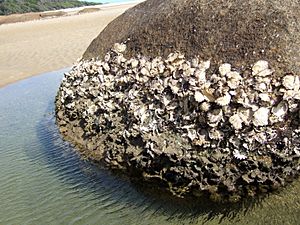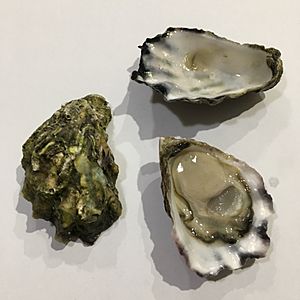Saccostrea glomerata facts for kids
Quick facts for kids Saccostrea glomerata |
|
|---|---|
 |
|
| Oysters on a rock at low tide, Wingan Inlet | |
| Scientific classification | |
| Genus: |
Saccostrea
|
| Species: |
glomerata
|
| Synonyms | |
|
Saccostrea commercialis |
|
The Saccostrea glomerata is a type of oyster that lives only in Australia and New Zealand. In Australia, it is known as the Sydney rock oyster and is grown on farms for people to eat. In New Zealand, where it is not farmed, it is called the New Zealand rock oyster or Auckland oyster. This oyster is related to the Saccostrea cucullata, also known as the hooded oyster, which is found on rocky shores in the Indo-Pacific region.
Sydney rock oysters can live in water with many different salt levels. You usually find them in the area between high and low tide, or up to 3 feet (1 meter) below the low-water mark.
Where Do They Live?
In Australia, you can find Sydney rock oysters in bays, inlets, and calm estuaries. They live from Wingan Inlet in eastern Victoria, all along the east coast of New South Wales, and north to Hervey Bay, Queensland. They also live around northern Australia and south along the west coast to Shark Bay in Western Australia. Baby oysters, called spat, travel down Australia's east coast on the East Australia Current. There are also small groups of these oysters on islands in the Furneaux archipelago in Bass Strait, and in Albany, Western Australia, where they are farmed.
Life Cycle and Reproduction
Sydney rock oysters are "broadcast spawners." This means they release their eggs and sperm into the open water, where they join together. Within a few hours, the eggs turn into tiny, free-swimming planktonic larvae. These larvae swim in estuary and coastal waters for up to three weeks. During this time, they grow clear shells and small feet that they can pull in.
The larvae then use their feet to find clean, hard surfaces to attach to. Once they are attached, they no longer need their feet, and they absorb them. Their shells get darker, and the tiny animal starts to look like an adult oyster.
How fast they grow depends on where they live. But generally, they reach about 50 grams (1.7 ounces) in three years. Sydney rock oysters can change their sex during their lives. Many start as males and later become females. About 60% of the oysters that are ready to eat are female. Farmers have worked to breed oysters that grow faster, so now they can be ready for market in two years instead of three. They have also had great success in breeding oysters that can fight off diseases.
Oysters are "filter feeders." This means they clean the water by straining out tiny algae (like tiny plants) that they eat. Many animals like to eat Sydney rock oysters, including birds, fish, stingrays, mud crabs, and starfish. The Australian pied oystercatcher especially loves them!
Oyster Farming
There is a big business of farming Sydney rock oysters in New South Wales and southern Queensland. A smaller, newer industry is growing in Albany, Western Australia. This industry creates a special food product and provides jobs in small towns along the coast. In Australia, oysters that are plump and ready to spawn are preferred for eating raw on the half-shell.
Eating Sydney Rock Oysters
Sydney rock oysters taste best when they are freshly opened. However, if you keep them whole and at the right temperature, they can stay fresh for up to 14 days.


